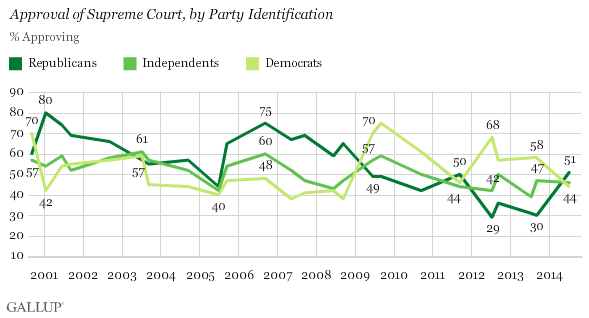WASHINGTON, D.C. -- Americans remain divided in their assessments of the U.S. Supreme Court, with 47% approving of the job it is doing, and 46% disapproving. These ratings are consistent with approval last September, when 46% approved and 45% disapproved, and rank among the lowest approval ratings for the court in Gallup's 14-year trend.

Since Gallup began asking the question in 2000, Americans have typically been more likely to approve than to disapprove of the job the Supreme Court is doing. However, the margin between the two has been narrowing since its recent high point in 2009, and Americans were divided over the court in 2012 and again in 2013. Separate polling found that confidence in the Supreme Court also fell to record lows this year, as Americans' confidence in all three branches of government is down.
The current approval ratings were measured July 7-10, after a controversial 2013-2014 term. Several recent court decisions allowed prayers in city council meetings; determined that the buffer zones around abortion and contraception medical centers in Massachusetts were too large and hampered free speech; said a public union could not force home-care workers to join the union and pay dues; and, perhaps the most well known, permitted family-owned businesses (in a suit brought by Hobby Lobby) to opt out of providing certain types of contraceptive coverage for employees if doing so was in conflict with the owners' religious beliefs.
Republican Approval for the Supreme Court Increases
Republican approval of the Supreme Court is up 21 percentage points since last September, from 30% in 2013 to 51%. Independents' approval shows little change, going from 47% to 46%. Support among Democrats, on the other hand, is down. In September, Democrats were the most approving group, at 58%, while in the current survey their approval is as low as independents', at 44%. Democrats are now slightly more likely to disapprove (50%) than approve (44%).

Support among Republicans may have increased this year in response to the court's 5-4 decision in Hobby Lobby's favor. At the same time, that decision likely cost the court some support from Democrats. Democratic leaders in Congress have expressed public disagreement with this ruling and are trying to pass a bill to override it.
Prominent Supreme Court decisions have led to changes in approval by party in the past. For example, in early 2001, just weeks after the Bush v. Gore decision effectively made George W. Bush the winner of the 2000 presidential election, Republican approval of the high court reached 80%. In 2012, after a landmark decision about the Affordable Care Act, support among Democrats increased to 68%, close to a record high among that group.
Bottom Line
Americans remain split on the job the Supreme Court is doing, and the current approval rating is on the low end of what Gallup has measured since it began asking the question in 2000. The biggest change in Americans' views of the court this year has been the flip in partisan approval.
Controversial decisions since 2012 have resulted in dramatic changes in views of the court among Americans of different party affiliations. However, this term, nearly two-thirds of the court's decisions were unanimous, in contrast to the 5-4 split in the two high-profile cases at the end. Americans' current views more closely reflect the court's own ideological divisions in these two recent decisions, rather than its bipartisan unanimity.
Survey Methods
Results for this Gallup poll are based on telephone interviews conducted July 7-10, 2014, on the Gallup Daily tracking survey, with a random sample of 1,013 adults, aged 18 and older, living in all 50 U.S. states and the District of Columbia.
For results based on the total sample of national adults, the margin of sampling error is ±4 percentage points at the 95% confidence level.
Interviews are conducted with respondents on landline telephones and cellular phones, with interviews conducted in Spanish for respondents who are primarily Spanish-speaking. Each sample of national adults includes a minimum quota of 50% cellphone respondents and 50% landline respondents, with additional minimum quotas by time zone within region. Landline and cellular telephone numbers are selected using random-digit-dial methods. Landline respondents are chosen at random within each household on the basis of which member had the most recent birthday.
Samples are weighted to correct for unequal selection probability, nonresponse, and double coverage of landline and cell users in the two sampling frames. They are also weighted to match the national demographics of gender, age, race, Hispanic ethnicity, education, region, population density, and phone status (cellphone only/landline only/both, and cellphone mostly). Demographic weighting targets are based on the most recent Current Population Survey figures for the aged 18 and older U.S. population. Phone status targets are based on the most recent National Health Interview Survey. Population density targets are based on the most recent U.S. census. All reported margins of sampling error include the computed design effects for weighting.
In addition to sampling error, question wording and practical difficulties in conducting surveys can introduce error or bias into the findings of public opinion polls.
View survey methodology, complete question responses, and trends.
For more details on Gallup's polling methodology, visit www.gallup.com.
